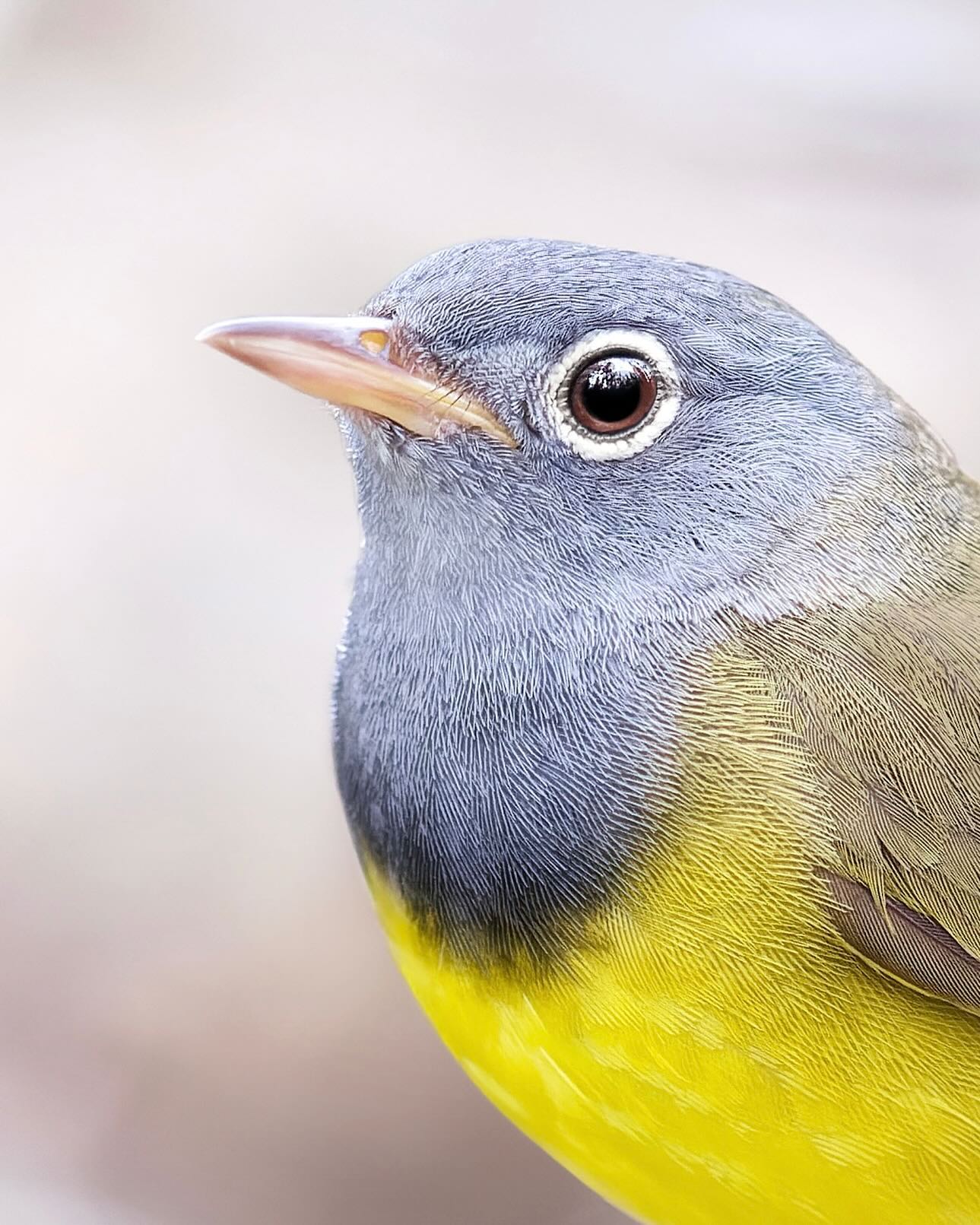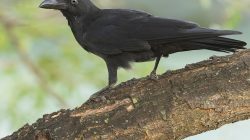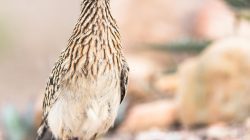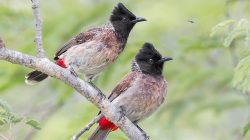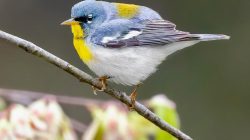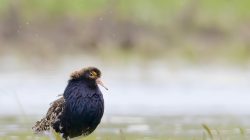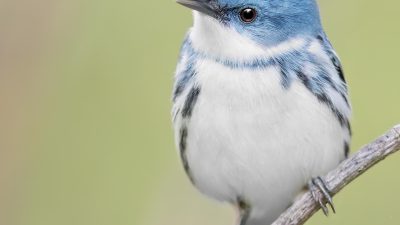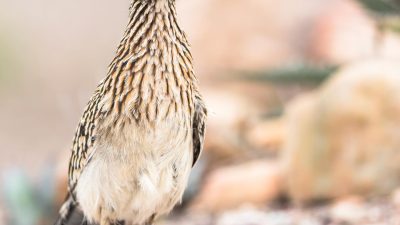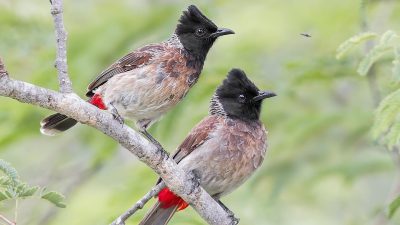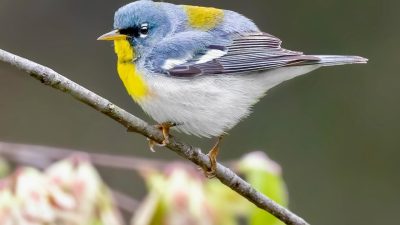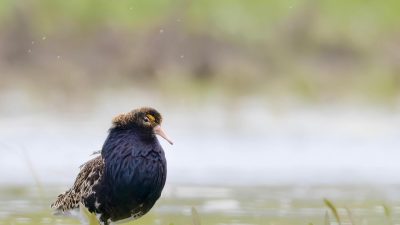The Connecticut Warbler (Oporornis agilis)
Diajar.net –The Connecticut Warbler (Oporornis agilis) is one of the most elusive and intriguing bird species in North America. Known for its secretive behavior and distinct characteristics, this species has been the subject of much study and fascination among ornithologists. In this article, we explore the Connecticut Warbler’s origin, appearance, distribution, geography, habits and lifestyle, diet and nutrition, population numbers, and its conservation status.
Origin of Animal Name
The name “Connecticut Warbler” is somewhat misleading, as it is not directly associated with the state of Connecticut. The species was first described in 1811 by the naturalist Alexander Wilson, who named it after the state, even though it is not particularly common there. The genus Oporornis, to which the Connecticut Warbler belongs, comes from the Greek word “oporos,” meaning “a meadow,” and “ornis,” meaning “bird,” which reflects the bird’s preference for shrubby, grassy habitats. The specific epithet agilis comes from Latin, meaning “nimble” or “agile,” describing the bird’s elusive and swift movements. Despite its name, the Connecticut Warbler is rarely seen in Connecticut itself and is primarily found in other areas during its migration periods.
Appearance
The Connecticut Warbler is a medium-sized songbird, characterized by its slightly rounded wings and a long, slender body. Adult Connecticut Warblers have a distinctive appearance that sets them apart from other warblers in their range. Their plumage is a soft, grayish-olive above, with pale, yellowish underparts, creating a stark contrast. The face of the Connecticut Warbler is one of its most distinctive features, marked by a dark grayish-black mask that extends from the beak to the throat, giving it a “bandit” appearance. Its eyes are bright yellow, and it has a slightly curved beak that is well adapted for its insectivorous diet.
Adult males tend to have a slightly darker and more defined face mask, while females and juveniles have more subdued coloring. The Connecticut Warbler’s tail is moderately long and slightly rounded, which it often flicks during foraging. These birds are known for their skulking behavior, often remaining hidden in dense underbrush and low vegetation, making them difficult to spot despite their striking appearance.
Distribution
The Connecticut Warbler is a migratory bird, breeding primarily in the dense, lowland forests of the northern parts of North America, including Canada and the northeastern United States. During the summer months, they are found across the boreal forests and dense shrubs, especially in the regions of the Great Lakes and parts of New England, including New York and parts of New England. These birds prefer dense, damp habitats, such as bogs and marshes, where vegetation provides ample cover for their elusive nature.
During the winter, the Connecticut Warbler migrates southward to Central and South America, particularly the tropical forests of Honduras, Nicaragua, and Panama. They have been known to travel thousands of miles to their wintering grounds. Their migratory patterns are often erratic, with some birds taking more direct routes, while others make detours through southern Mexico. Although their wintering habitats are largely unstudied, it is believed that they prefer the dense foliage and sheltered environments of tropical regions, much like their breeding grounds in the north.
Geography
The Connecticut Warbler’s geographical range is limited, especially during the breeding season. Its range is primarily found in the boreal forests and forested wetlands of Canada, particularly in the provinces of Ontario, Quebec, and the Maritimes. In the United States, the Connecticut Warbler breeds sporadically in parts of the Great Lakes region, including Michigan, Wisconsin, and parts of New York and the northern Appalachian Mountains.
However, the bird’s presence is not uniform within this range. During the breeding season, Connecticut Warblers are often difficult to locate because they prefer dense, inaccessible vegetation, such as wetlands or forests with thick underbrush. Their distribution during migration, on the other hand, is more expansive, with the birds moving through the southern United States before continuing to their wintering grounds.
The Connecticut Warbler’s migration routes, although poorly understood in some areas, are mostly concentrated in areas with dense shrubland and forests. This geographical distribution and their choice of breeding and wintering habitats reflect the bird’s need for a particular set of environmental conditions, such as dense vegetation for protection from predators and a variety of insects for food.
Habits and Lifestyle
The Connecticut Warbler is renowned for its elusive and secretive nature. It is a solitary bird, often found in dense underbrush and thick foliage, where it remains concealed from view for much of the time. Unlike many other songbirds, the Connecticut Warbler does not typically engage in loud, conspicuous calls or songs. Instead, it communicates through short, low-pitched whistles and calls, which can be heard from a distance but are not as distinct as those of more common warblers.
Their lifestyle is largely solitary, except during migration when they may congregate in small, temporary groups. They are more active during dawn and dusk, foraging for food while remaining well hidden in the underbrush. Their behavior is typically characterized by constant movement, as they flit through the low shrubs and undergrowth, often using their wings to make short, quick bursts of flight between patches of vegetation. They are known for being difficult to observe, and even birdwatchers with keen eyes often struggle to spot them.
These birds are also known to be territorial during the breeding season, although they tend to keep their distance from other birds and avoid direct interaction. When not breeding, they exhibit more nomadic tendencies, as they forage across large areas for food, particularly during migration.
Diet and Nutrition
The Connecticut Warbler is primarily insectivorous, relying on a diet of insects and other small invertebrates. During the breeding season, they feed on a variety of insects, including beetles, caterpillars, and ants, as well as spiders and other arthropods found in the dense foliage of their habitats. They use their slender beaks to forage for prey in the underbrush, picking insects from the leaves and branches of shrubs and trees.
While they are most active during the day, the Connecticut Warbler’s feeding behavior is more subdued compared to other warblers. They often forage alone, hopping from plant to plant in search of food. During migration, they continue to feed on insects and may also supplement their diet with fruits and berries, although their diet during migration is less well-documented. They are known to prefer environments where insect populations are abundant, such as marshes, bogs, and moist forests, which provide an ample food supply for the birds.
In their wintering grounds, it is believed that the Connecticut Warbler continues to feed on a variety of insects found in tropical forests. These insects are often larger and more diverse than those found in the bird’s breeding habitat, providing the warbler with the nutrition it needs during its long migration. The exact composition of the bird’s winter diet is not well understood due to limited field research in its tropical habitats.
Population
The Connecticut Warbler is considered a species of conservation concern due to its limited population size and specialized habitat requirements. While the exact number of individuals is difficult to determine, estimates suggest that the global population of Connecticut Warblers is relatively small compared to other warbler species. The bird’s secretive nature, combined with its preference for dense, inaccessible habitats, makes it challenging to accurately assess population numbers.
Estimates of the Connecticut Warbler’s breeding population vary widely, but it is believed that there are fewer than 200,000 individuals in total. The population is scattered across its breeding range, and some of the best estimates come from monitoring programs conducted in Canada and parts of the northeastern United States. The Connecticut Warbler is considered to be rare in many parts of its range, with only a handful of known breeding sites and an irregular distribution pattern.
Despite its relatively low numbers, the Connecticut Warbler is not classified as critically endangered. However, its population is vulnerable to changes in its environment, particularly the loss of suitable habitat due to logging, urban development, and changes in land use. Habitat degradation and fragmentation, particularly in the bird’s breeding grounds, pose significant threats to the species.
Number of Populations
The Connecticut Warbler is known to have a fragmented population, with distinct breeding populations scattered across its range. These populations are primarily located in the northern parts of North America, particularly in the boreal forests and wetlands of Canada and the northern United States. There are a few key breeding areas, such as those in Ontario, Quebec, and parts of the Great Lakes region, where the Connecticut Warbler is more commonly found.
Due to the bird’s secretive nature and limited distribution, the number of known populations is difficult to pinpoint. However, conservationists have identified several key areas where the Connecticut Warbler is most likely to be found during the breeding season. These populations are often isolated from one another, and genetic studies have shown that there is little to no gene flow between distant populations.
While the Connecticut Warbler’s populations are spread across a large area, their numbers are relatively low in each breeding region, contributing to the species’ overall vulnerability. Conservation efforts aimed at protecting the bird’s habitat are crucial to maintaining these populations and preventing further declines.
Conservation
The Connecticut Warbler is classified as a species of “Least Concern” by the International Union for Conservation of Nature (IUCN). However, this classification does not mean the species is without risk. The Connecticut Warbler faces significant threats from habitat loss, particularly in its breeding grounds. The bird’s reliance on dense, lowland forests and wetlands makes it especially vulnerable to deforestation, drainage of wetlands, and changes in land use.
Climate change is also a growing concern for the Connecticut Warbler, as shifts in temperature and precipitation patterns may alter the bird’s habitat and food availability. The loss of suitable breeding and wintering habitats due to environmental changes could have a profound impact on the species’ survival. Additionally, the fragmentation of habitats poses a significant threat, as small, isolated populations are more vulnerable to extinction.
Conservation efforts for the Connecticut Warbler are focused on preserving its habitat, particularly the boreal forests and wetlands that provide the dense underbrush the bird needs for shelter and food. Efforts to mitigate the effects of climate change and habitat destruction are also crucial to the bird’s long-term survival. Restoration projects aimed at replanting forests and protecting wetlands in key areas have been undertaken in recent years, and more work is needed to ensure the continued survival of the species.
Conservationists also emphasize the importance of public awareness and education about the Connecticut Warbler. By understanding the species’ needs and threats, communities and policymakers can work together to protect its habitats and ensure that this elusive bird remains a part of North America’s avian diversity for generations to come.
Conclusion
The Connecticut Warbler is a fascinating and mysterious bird, known for its elusive behavior and unique habitat preferences. While it is not currently classified as endangered, the species faces significant challenges due to habitat loss, climate change, and population fragmentation. Through concerted conservation efforts and continued research, there is hope that the Connecticut Warbler will continue to thrive in the forests and wetlands of North America for many years to come.
